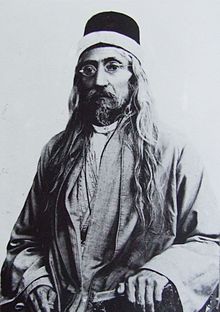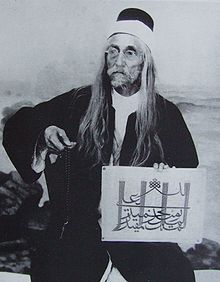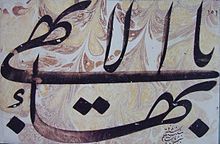Mishkin-Qalam
Mishkin-Qalam ( Persian مشكن قلم Mischkin Kalam ) was the honorary title of the leading Iranian calligrapher Mirza Husayn-i-Isfahani (* 1826 in Shiraz , Iran ; † 1912 in Bahji near Akkon , Palestine , Ottoman Empire ). He was also a prominent Baha'i and one of the 19 apostles of Baha'u'llah .
Life
Early years
Mirzá Husayn-i-Isfaháni, who had mastered every calligraphy style, engraved a picture of the Shah's first minister on the back of a piece of paper when he was about 25 years old. As a result, Naser ad-Din Shah became aware of Mirzá Husayn-i-Isfaháni's calligraphic talents and appointed him teacher to the Crown Prince. It is said that the Shah himself gave the calligrapher the title Mishkin- Qalam , which means musky or pitch-black feather. During a brief leave of absence from the Shah's court, Mishkin-Qalam, who was a dervish , went to Isfahan and met a Baha'i there and then accepted the faith. He did not return to the Shah's court, but traveled to Edirne and there came into the presence of Baha'u'llah . From that time on, his life was fully dedicated to the Baha'i Faith and signed his calligraphy "The Servant at the Gate of Bahá, Mishkin Qalam". Among other things, he wrote the Greatest Name , Yá Bahá'u'l-Abhá, O You Glory of the Most Glorious, in various forms and sent these calligraphy everywhere. One of these forms became the standard symbol of the Baha'i Faith. Some time later, Mishkin-Qalam, apparently on the orders of Baha'u'llah, went to nearby Istanbul , where he made a number of calligraphy for the Ottoman Sultan Abdülaziz . Unfortunately, he had an enemy in the Persian ambassador to court who betrayed him and saw that Mishkin-Qalam was finally imprisoned in 1867 for belonging to the Baha'i group.
Cyprus
When Baha'u'llah and his company were exiled to Acre in 1868 , Mishkin-Qalam was deported to Famagusta on Cyprus together with three other followers of Baha'u'llah in the wake of Subh-i-Azal . Despite his imprisonment, he was able to do his calligraphy. When Cyprus fell under British sovereignty in 1878 , Mishkin-Qalam applied for release from Cypriot captivity, but had to wait until September 1886 due to bureaucratic hurdles. That month he took a ship to Acre to Baha'u'llah.
Last years
In Acre he taught the art of handwriting and made calligraphic copies of numerous Baha'i scripts. A copy of the Hidden Words in the calligrapher's handwriting has been published in Germany. In Acre Mishkin-Qalam also got to know the orientalist Edward Granville Browne , who integrated the calligrapher and the meeting with him in the report of his stay in Acre. After the death of Baha'u'llah in 1892, Mishkin-Qalam traveled to Egypt , Damascus and India . In India he also worked on the first publications of the Baha'i religion in that country. There, too, he made calligraphy. When Abdul-Baha heard that the calligrapher was old and weak, he asked him to come back to Acre in 1905. A description of Mishkin-Qalam in old age can be found in the novella "The Mountain of God" by Ethel Stefana Stevens, who later became Lady Drower.
One of the last services that Mishkin-Qalam rendered to the Baha'i Faith was the design of the ornate inscriptions on the marble sarcophagus that the Baha'i of Myanmar had donated for the remains of the Bab . Much of the calligraphy is in Baha'i archives, exhibited in Baha'i centers, or privately owned by Baha'i around the world. Some pieces can even be found in well-known museums, such as the pictorial representation of a rooster made of letters, which is in the M. Sackler Museum at Harvard University . Mishkin-Qalam lived in Bahji north of Acre until his death.
Individual evidence
- ↑ Hasan Balyuzi : Eminent Bahais in the Time of Baháulláh with Some Historical Background . Ed .: George Ronald. Oxford, UK 1985, ISBN 0-85398-152-3 , pp. 270-272 .
- ↑ Baha'u'llah: Kalimát-i-maknúnih, the hidden words . Bahai-Verlag, Hofheim-Langenhain 1983, ISBN 3-87037-916-2 .
- ^ Moojan Momen (Ed.): The Bábí and Baháí-Religions, 1844-1944: Some Contemporary Western Accounts . George Ronald, Oxford, UK 1981, ISBN 0-85398-102-7 , pp. 228 .
- ↑ Ethel Stefena May Stevens: The Mountain of God . Mills and Boon, London 1911, p. 110-112 .
literature
- Abdu'l-Bahá: Role Models of Faithfulness : Memories of Early Believers . Bahai-Verlag, Hofheim-Langenhain 1987, ISBN 3-87037-195-1 , p. 127-131 ( online ).
- Society for Persian Letters & Arts: Mishkín Qalam: XIX Century Artist & Calligrapher . Reyhani, Darmstadt 1992, ISBN 3-906714-01-2 .
- Adib Taherzadeh: The Revelation of Bahá'u'lláh, Volume 1: Baghdad 1853-63 . Bahai-Verlag, Hofheim-Langenhain 1981, ISBN 3-87037-123-4 , p. 46-48 .
- Bahíyyih Nakhjaváni: Four on an Iceland . George Ronald, Oxford, UK 1983, ISBN 0-85398-174-4 .
- Julie Oeming Badiee and Heshmatollah Badiee: The calligraphies of Mishkín-Qalam in Vol. 6 of the series of publications of the Society for Baha'i Studies, Art: Servant of Unity? Bahai-Verlag, Hofheim 2001, ISBN 3-87037-383-0 , p. 81-105 .
Web links
- Biography with pictures (English)
- The Conservation and Restoration of a 19th Century Calligraphy of a Baha'i Writing in Arabic (English)
| personal data | |
|---|---|
| SURNAME | Mishkin-Qalam |
| ALTERNATIVE NAMES | Husayn-i-Isfahani, Mirza (maiden name) |
| BRIEF DESCRIPTION | Persian calligrapher and Baha'i |
| DATE OF BIRTH | 1826 |
| PLACE OF BIRTH | Shiraz , Iran |
| DATE OF DEATH | 1912 |
| Place of death | Bahji near Akkon , Palestine , Ottoman Empire |


